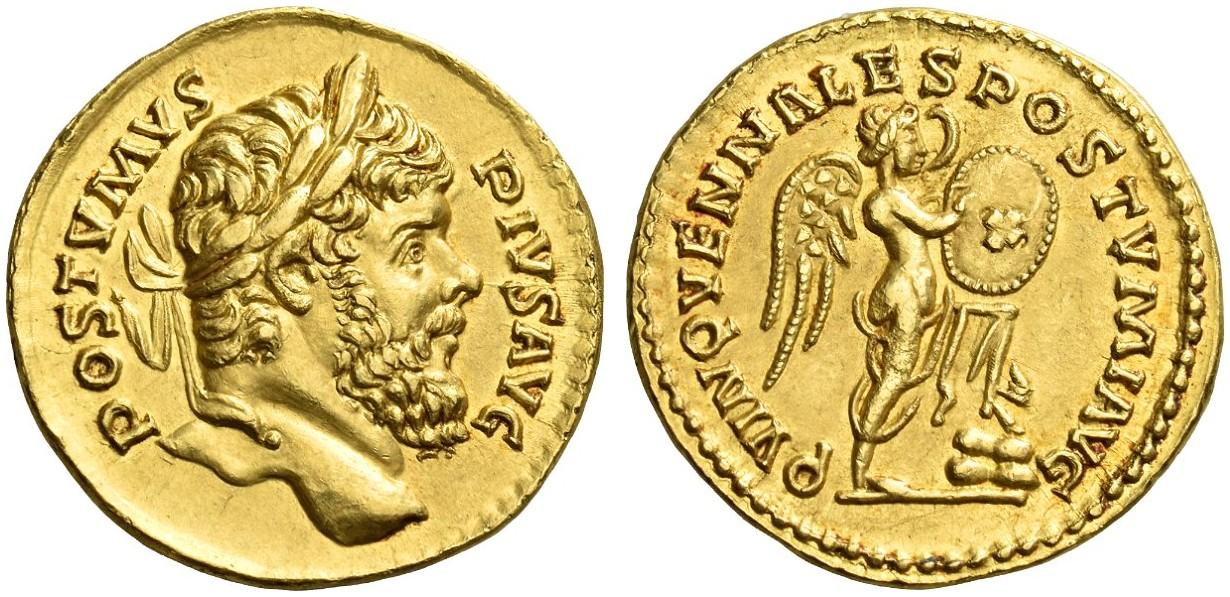Lugdunum (Postumus), gold, aurei (260-269 CE)
From SILVER
260 CE - 269 CE Gold 146,757 kg
Description
| ObverseInscription or printing placed on the obverse.: | Various legends. Here: POSTVMVS – PIVS AVG (Latin).Laureate head r. |
| ReverseInscription or printing placed on the reverse.: | Various legends. Here: QVINQVENNALES POSTVMI AVG (Latin).Various types. Here: Victory standing r., l. foot on cuirass, writing on shield set on her knee |
Mint and issuing power
| MintIdentifies the place of manufacture or issue of a numismatic object.: | Lugdunum | Ancient regionAncient region.: | Gaul | Modern countryModern country: France | AuthorityIdentifies the issuing power. The authority can be "pretended" when the name or the portrait of X is on the coin but he/she was not the issuing power. It can also be "uncertain" when there is no mention of X on the coin but he/she was the issuing power according to the historical sources: | Roman Empire, Postumus (260-269 CE) |
Chronology
| FromIdentifies the initial date in a range assigned in a numismatic context. | 260 CE | toIdentifies the final date in a range assigned in a numismatic context.. | 269 CE | PeriodTime period of the numismatic object.: Roman from 30 BC |
Physical description
| MetalThe physical material (usually metal) from which an object is made.: | Gold |
Median weightMedian of the weights of numismatic objects (in grams). in grams | 5.90 | DenominationTerm indicating the value of a numismatic object. Examples: tetradrachm, chalkous, denarius.: | aureus | StandardStandard.: |
Image

Postumus aurei.jpg [1]
References
| Die study referencePublication of the study: | Schulte 19831Schulte 1983, p. 72-120, n° 1-165 | ||
| Coin series referenceReference to coin series study: | |||
Obverse dies distribution
| FrequencyFrequency of specimen in distribution. ᵖ | Number of obversesNumber of obverse dies. ᵖ (o) | % (o) | Number of coinsNumber of coins. (n) | % (n) | Die nameName(s) of the die(s). |
| 1 | 37 | 38.54 | 37 | 13.36 | 1, 2, 3, 5, 13, 15, 16, 17, 28, 32, 36, 38, 40, 41, 42, 44, 45, 46, 50, 52, 54, 57, 58, 60, 61, 62, 63, 64, 65, 66, 68, 74, 76, 87, 88, 95, 96 |
| 2 | 27 | 28.13 | 54 | 19.49 | 4, 7, 8, 9, 10, 11, 18, 23, 24, 25, 26, 29, 30, 33, 39, 47, 49, 51, 59, 69, 70, 73, 75, 85, 89, 91, 92, 93 |
| 3 | 11 | 11.46 | 33 | 11.91 | 6, 12, 31, 34, 37, 53, 81, 84, 86, 90, 94 |
| 4 | 4 | 4.17 | 16 | 5.78 | 14, 19, 36, 56 |
| 5 | 4 | 4.17 | 20 | 7.22 | 21, 35, 48, 67 |
| 6 | 2 | 2.08 | 12 | 4.33 | 22, 79 |
| 7 | 3 | 3.13 | 21 | 7.58 | 20, 55, 78 |
| 8 | 1 | 1.04 | 8 | 2.89 | 77 |
| 9 | 2 | 2.08 | 18 | 6.5 | 43, 71 |
| 10 | 2 | 2.08 | 20 | 7.22 | 27, 82 |
| 11 | 1 | 1.04 | 11 | 3.97 | 80 |
| 13 | 1 | 1.04 | 13 | 4.69 | 72 |
| 14 | 1 | 1.04 | 14 | 5.05 | 83 |
| Total | 96 of 96 | 100 | 277 of 277 | 99.99 |
Reverse dies distribution
no distribution is available
Quantification
| Number of obversesNumber of obverse dies. ᵖ (o) | 96 | Number of singletons (o1)The number of singleton coins. ᵖ | 37 |
| Number of reverse diesNumber of reverse dies. (r) | 114 | Number of coinsNumber of coins. (n) | 277 |
| Coins per obverse dieNumber of coins per obverse die. (n/o) | 2.89 | Coins per reverse dieNumber of coins per reverse die. (n/r) | 2.43 |
| Reverse per obverse ratioRatio of obverse dies divided by reverse dies. (r/o) | 1.19 | Percentage of singletons (o1)number of coins (n) divided by the number of singletons (o1) ᵖ | 38.54 % |
| Original number of dies (O) (Carter 1983 formula)The estimation of the number of coins according to Carter 1983 ᵖ | 124.37 | Coins struck if 20,000 as average productivity per dieCoins made if the average productivity for obverses (according to Carter) is 20,000. ᵖ | 2,487,400 |
| Original number of dies (O) (Esty 2011 formula)The estimation of the number of coins according to the singleton formula in Esty 2011 ᵖ (O) | 146.92 | Survival rate if 20,000 as average productivity per dieSurvival rate if average productivity is 20,000. ᵖ | 0.00011 |
| Coverage (o = % of O) (Esty 1984 formula)Esty 1984 - coverage (% of O) ᵖ (o = % of O) | 86.64% | Die productivity if survival rate 1/2,000Average productivity if survival rate is 1/2,000. ᵖ | 4,454.45 |
| Weight of silver (in kg) if 20,000 coins per die (O = Carter formula)Carter 1983 * Median weight * 20000 (*10 if gold or electrum) ᵖ | 146,757 kg <br /> 146,757 kg | Die productivity if survival rate 1/5,000Average productivity if survival rate is 1/5,000. ᵖ | 11,136.13 |
Remarks
Most likely more than 2 workstations Certainly military